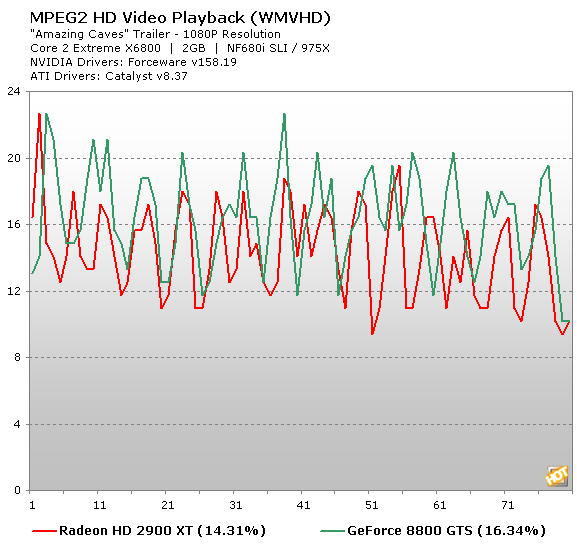ATI Radeon HD 2900 XT - R600 Has Arrived
AVIVO Video Performance

For our first round of performance related tests we took a look at Digital Video processing performance of the two competing core GPU architectures. "PureVideo HD" technology is at work here for NVIDIA and "AVIVO HD" for ATI.
|
|
|
To illustrate CPU utilization while playing back WMV HD content, we used the Performance Monitor built into Windows XP. Using the data provided by Windows Performance Monitor, we created a log file that sampled the percent of CPU utilization every second, while playing back the 1080p versions of a couple of short video clips. One test was conducted using the "Amazing Caves" video that's available for download on Microsoft's WMVHD site. Another test was conducted using the "Evan Almighty" trailer available for download on Apple's QuickTime website. The Amazing Caves video is compressed using MPEG2, while the Evan Almightily clip uses H.264. The CPU utilization data gathered during these tests was then imported into Excel to create the graph below. The graph shows the CPU utilization for a GeForce 8800 GTS and a Radeon HD 2900 XT using Windows Media Player 10 to playback the WMVHD clip and PowerDVD for the QuickTime clip.

Both the Radeon HD 2900 XT and GeForce 8800 GTS had no trouble playing back the Amazing Caves video. The Radeon used somewhat less CPU horsepower, but both offloaded the vast majority of work from the host processor and produced smooth, fluid playback of the video.

The tides turned while playing back the H.264 encoded Evan Almighty trailer. Here, the GeForce 8800 GTS dropped host CPU utilization to about 16.3% while the Radeon HD 2900 XT dropped it to about 20%. Playing back the video without hardware acceleration resulted in about 85% of the CPU's resources to be used, however. So, while the GeForce did a slightly better job here, both are a huge improvement over software-only players.
** Update: Please note that H.264 encoded Blu-Ray or HD DVD titles will likely have higher-CPU utilization on the Radeon HD 2900 XT because it does not feature the new UVD. Unencrypted clips like the trailer we used here, aren't as demanding to play on a PC.
|
|
|
Next up, we have the HQV DVD video benchmark from Silicon Optics. HQV is comprised of a sampling of SD video clips and test patterns that have been specifically designed to evaluate a variety of interlaced video signal processing tasks, including decoding, de-interlacing, motion correction, noise reduction, film cadence detection, and detail enhancement. As each clip is played, the viewer is required to "score" the image based on a predetermined set of criteria. The numbers listed below are the sum of the scores for each section. We played the HQV DVD using the latest version of Cyberlink's PowerDVD, with hardware acceleration for AVIVO and PureVideo extensions enabled.

The HQV benchmark has lost much of its luster with us. Not only because both ATI's and NVIDIA's respective architectures produce near perfect scores (130 points is a perfect score here), but because this benchmark leaves a portion of the scoring open to interpretation and depending who you talk to (Silicon Optics, Intel, NVIDIA, ATI, etc.) you'll likely get a different answer as to how to score a particular product. Regardless, thanks to AVIVO and PureVideo, the PC is the premiere platform for playing most SD content. You've got to spend thousands of dollars to get a DVD player than can product similar results in this benchmark.






